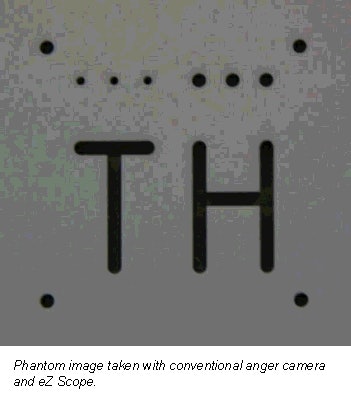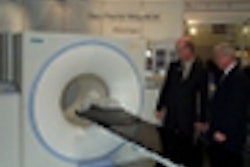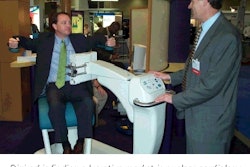
Despite years of R&D, solid-state detector technology using cadmium zinc telluride (CZT) crystals has yet to take off. Although its potential benefits include better resolution than conventional gamma cameras, the problem of producing and processing CZT continues to dog manufacturers.
Now a Pennsylvania CZT supplier and device manufacturer, eV Products, is using this week's Society of Nuclear Medicine meeting to introduce two small-field-of-view gamma cameras that use CZT detectors: eZ Scope, a 256-channel device, and an as-yet-unnamed 64-channel strip detector.
eV Products of Saxonburg, PA, developed eZ Scope for a Japanese partner, Anzai Medical of Tokyo. Intended to produce both topographical and planar images, the device is small, measuring 60 x 60 x 200 mm and weighing about 1.5 lbs. It consists of a handheld probe with an LED display, an articulating arm, and a single CZT detector tile that measures 32 x 32 mm and is 5-mm thick. The detector has 256 channels of signal-processing electronics and spatial resolution of 2-mm pitch. Anzai will package the device with a computer workstation.
"There are significant differences between [eZ Scope] and conventional Anger cameras," said Chris Bickel, sales and marketing manager at the company. "eZ Scope makes topographical images possible without the rotation that’s necessary with a conventional camera, and it also has much higher spatial resolution of 2 mm as compared to three to five times that with conventional camera."
 |
Anzai Medical debuted eZ Scope in April 2001 at the Japan Industries Association of Radiological Systems show in Kobe, Japan. The company is conducting phantom trials with the device at two Japanese universities, and is in discussion with the University of Houston about conducting a U.S. clinical trial there. Anzai plans to apply for Food and Drug Administration clearance for the unit by the end of 2001, and is exploring potential distribution channels now, according to eV Products.
 |
In addition to eV Scope, eV Products has developed a 64-channel strip nuclear medicine device for Anzai that clinicians can use on a particular area of interest, such as a breast or the thyroid, to collect diagnostic data in slices, according to Bickel.
"We’re developing a strip device that radiologists will use to take diagnostic slice data once an area of interest has been identified," he said. "There’s potential to have better 2-D slice capability and depth resolution than [what] a 3-D small-field-of-view gamma camera offers, so that when a clinician is trying to reconstruct or fuse images he’d have better information from the particular slice."
eV Products is the 10-year-old subsidiary of II-VI, a manufacturer of laser optic materials, optics, components, electro-optical products, and radiation detection devices. Established in 1971, II-VI has more than 600 employees, and in addition to its 35,000-square-foot Saxonburg site, maintains facilities in Florida, Singapore, and China.
eV Products grows the raw material for radiation detectors, and also does electronic component design and assembly at its facility for distribution to medical and industrial OEMs. About half the subsidiary’s business is outside the U.S., although eV Products also counts such companies as GE Medical Systems, Neoprobe, and Norland Medical Systems among its clients.
In fact, eV Products worked with GE for six years on a CZT-based detector that would replace sodium iodide in a conventional gamma camera, according to eV Products, whose role in the project ended this year with the delivery of the detector material to GE. The collaboration resulted from the 1992 Oslo Peace Accord, which among other things, provided funds for industrial partners from the U.S. and Israel to develop new technology. eV Products and GE worked with an Israeli government firm, Soreq, as well as what was then Elscint. GE could not be reached for comment on the status of the project.
eV Products' work with GE indicates that large players in the nuclear medicine market are interested in developing solid-state gamma cameras. To date, only one company, Digirad of San Diego, has brought a solid-state unit to market, but its 2020tc Imager’s detectors use silicon phiodiode technology and cesium iodide crystals rather than CZT.
Why has eV Products succeeded in developing CZT for medical and industrial use? The firm credits its achievement to its parent company’s experience.
"Nuclear physicists have known about (CZT) for more than 40 years, but no one’s been able to produce it successfully," Bickel said. "II-VI has spent 30 years fine-tuning its method of growing the material, and has developed a way to produce a high percentage yield of single crystal per ingot of material with consistently high semiconductor properties."
By Kate Madden YeeAuntMinnie.com contributing writer
June 27, 2001
Related Reading
Marconi will develop whole-body solid-state gamma camera, June 20, 2001
Click here to post your comments about this story. Please include the headline of the article in your message.
Copyright © 2001 AuntMinnie.com





















